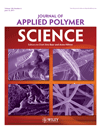The pH-responsive cycloterpolymers of diallyldimethylammonium chloride, 3-(N,N-diallylammonio)propanesulfonate, and sulfur dioxide
Abstract
The cycloterpolymerizations of diallyldimethylammonium chloride, 3-(N,N-diallylammonio)propanesulfonate, and sulfur dioxide afforded a series of pH-responsive cycloterpolymers in excellent yields. The solution properties of these ionic polymers were controlled by the composition of the monomeric units; exhibiting dominance either in polyzwitterionic or cationic character. The unquenched valency of nitrogen in the monomeric units of the sulfobetaine zwitterions has permitted these cationic/zwitterionic polymers to be converted into a series of polyampholytes with a charge asymmetry arising out of excess of either the cationic or anionic centers. The water-solubility of these polymers, upon low- and high-salt (NaCl) additions has been investigated to provide critical solution concentrations to promote water-insolubility and -solubility. A series of associating polymers of the above two monomers and SO2 with a hydrophobic incorporation of 3–7 mol % of diallyloctadecylammonium chloride has also been synthesized. The solubility and viscosity of the hydrophobically modified polymers in the polyampholytic form were increased considerably in the presence of anionic surfactant sodium dodecyl sulfate. © 2011 Wiley Periodicals, Inc. J Appl Polym Sci, 2011




